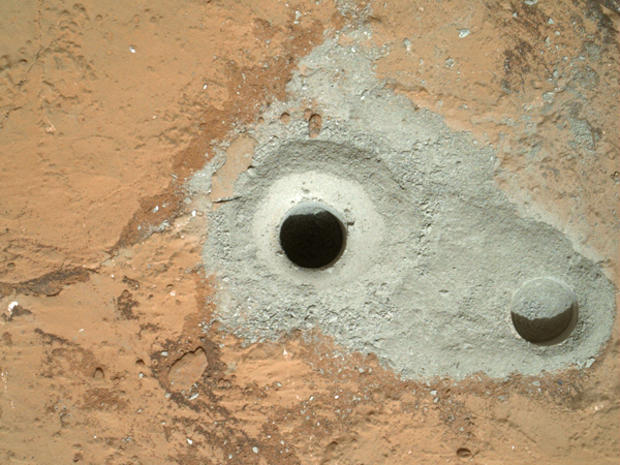In major milestone, Curiosity drills into Mars rock
In a long-awaited milestone, NASA's Curiosity Mars rover used its powerful drill for the first time Friday, beaming back pictures Saturday showing a pair of precisely bored holes in a flat reddish slab surrounded by a grey residue of crushed rock excavated from the interior.
The powdery debris may hold more clues about the role of water in the red planet's past. But in the near term, the successful test prompted NASA science chief John Grunsfeld to declare the nuclear-powered rover fully operational, calling the drilling operation "the biggest milestone accomplishment for the Curiosity team since the sky-crane landing last August."
Since Curiosity was lowered to the surface of Gail Crater Aug. 6, engineers have been systematically activating, calibrating and testing the rover's complex sample acquisition hardware, its robot arm and its laboratory instruments to make sure the spacecraft can meet its scientific objectives.
The goals of the planned two-year mission are to search for signs of organic compounds and to look for evidence of past or present habitability.
The powerful robot arm-mounted impact drill was the last major sample collection system to be tested and it appears to have worked as advertised, first drilling a test hole 0.63 inches across and 0.8 inches deep and then a sample collection hole 2.5 inches deep.
"We commanded the first full-depth drilling, and we believe we have collected sufficient material from the rock to meet our objectives of hardware cleaning and sample drop-off," Avi Okon, a drill engineer at NASA's Jet Propulsion Laboratory in Pasadena, Calif., said in a statement.
The drill is designed to channel rock powder into storage chambers before delivery to Curiosity's complex sample-handling system.
Actual analysis of the first drill sample will not begin until after engineers complete a process using part of the rock powder to "clean" the sample handling system to remove any contaminants that might have made it to the red planet from Earth.
"We'll take the powder we acquired and swish it around to scrub the internal surfaces of the drill bit assembly," Scott McCloskey, a drill systems engineer, said in a NASA statement. "Then we'll use the arm to transfer the powder out of the drill into the scoop, which will be our first chance to see the acquired sample."
The Collection and Handling for In-Situ Martian Rock Analysis, or CHIMRA, system is designed to vibrate a powder sample over a sieve to screen out any particles larger than 150 microns across, or six-thousandths of an inch.
After the cleaning process, some of the fine-grained rock collected by the drill will be delivered to ports on Curiosity's upper deck that will route it into the Chemistry and Mineralogy, or CheMin, suite of instruments for a detailed chemical analysis.
Another set of instruments, known as the Sample Analysis at Mars, or SAM, package is designed to look for signs of organic compounds like those necessary for life as it is known on Earth.
Louise Jandura, chief engineer for the sample acquisition system at JPL, said the successful drilling test was the culmination of an extensive test program on Earth to make sure the drill aboard Curiosity could "interact forcefully with unpredictable rocks on Mars."
"To get to the point of making this hole in a rock on Mars, we made eight drills and bored more than 1,200 holes in 20 types of rock on Earth," she said in the NASA statement.

